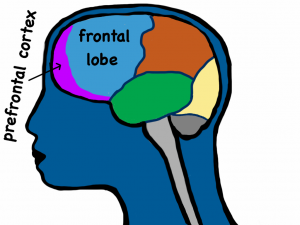Presented within the flow of the lives of real people and fictional characters, this is a monthly exploration of how parts of the brain work.
Unpredictable
by Leena Prasad
Clyde is sitting in front of a large white canvas. He starts to throw random colors onto the canvas and within a few minutes, an image starts to emerge. Several hours later, a rough draft of a painting is taking shape.
“Clyde, honey, you have a doctor’s appointment in forty-five minutes.” His wife, Irene, stands at the door watching him for few minutes before she finally interrupts.
As he heads out the door, she wonders once again how her husband’s mind works. As a research scientist, her work is so different than his that she is often in awe of her husband’s casual creative leaps of mind.
Irene has read a little bit about how the brain works. She knows that axons are the transport lines between brain neurons and they are protected by a material called the myelin sheath. White matter is the collection of axons and the thickness of the myelin sheaths determine the density of the white matter. White matter carries messages across the brain.
Irene reads about research done by Dr. Rex Jung, a neuroscientist who studies creativity. According to his findings, the white matter in the creativity circuits of the mind is denser in highly creative people, a similarity shared by people with bipolar disorder and schizophrenia. This is not to say that creative people suffer from psychopathology, rather that there are some similarities in the structure of the brain. Thicker white matter in some parts of the brain correlates to higher IQ whereas thinner white matter in other parts of the brain correlates to higher creativity (as defined by the researchers). Dense white matter carries information faster whereas thinner white matter slows down the transmission. This resonates with Irene because it seems to her that her thoughts travel in straight lines whereas Clyde’s mind sometimes takes loops and turns to go from one place to another.

Clyde is highly intelligent in addition to being very creative. So, this means that he has thick white matter in the IQ areas and thinner white matter in the creativity processing neurons. But there’s more to creativity than just the white matter. According to Jung, the prefrontal cortex, the brain’s planning and control center, takes a break when the mind is experiencing a creative moment. This clarifies how Clyde often forgets about practical matters when his mind switches to a creative mode. It also explains his ability to be playful without the pre-frontal cortex putting brakes on his uninhibited ability to have fun.
When Clyde walks through the door several hours later, he has a bagful of groceries in his hand and has remembered to bring everything on her list. Later, he pulls out a painting of a dozen yellow roses from his studio to surprise her. His wife is happy that his thick white matter, thin white matter, and pre-frontal cortex are working as a team to create a pleasant day for both of them.
Leena Prasad has a writing portfolio at FishRidingABike.com. Links to earlier stories in her monthly column can be found at WhoseBrainIsIt.com.
Josh Buchanan, a UC Berkeley graduate, edits this column with an eye on grammar and scientific approach.
References:
- Jung, Rex., White Matter Integrity, Creativity, and Psychopathology:Disentangling Constructs with Diffusion Tensor Imaging, PLoS ONE | www.plosone.org, March 22, 2010
- Tippett, Krista, host of Creativity and the Everyday Brain with Rex Young, On Being, May 2, 2013, http://www.onbeing.org/program/creativity-and-everyday-brain/1879



Pingback: Synchronized Chaos August 2013 – Artistic Renderings | Synchronized Chaos